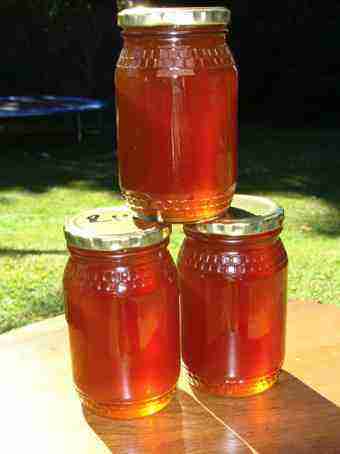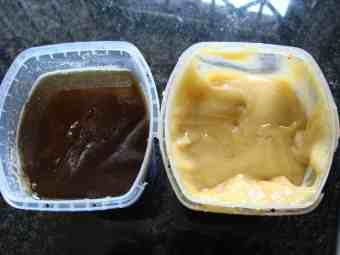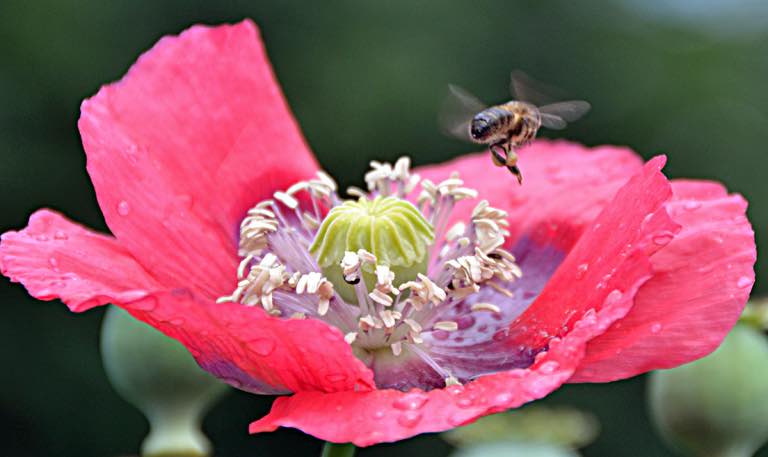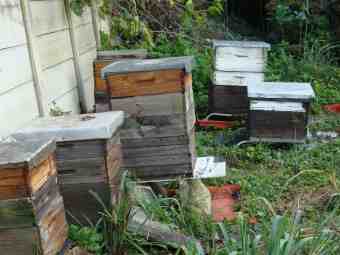- Bernard Preston homepage
- Our natural honey
Our natural honey
Natural honey consumption by diabetics is complex and controversial. Too much of a good-thing is not helpful; or is it?
Honey is made up of a mixture consisting mainly of two simple sugars.
- Fructose
- Glucose
It also contains various vitamins, minerals and enzymes; and a complex-assortment of phytonutrients depending on which plants the bees have been feeding.
The bees also add certain bioactive substances.

Honey is the natural sweet substance produced by Apis Mellifera bees from the nectar of flowers or from secretions of the living parts of plants.
Or excretions of plant-sucking insects on the living parts of stems and leaves which the bees collect and transform by combining them with specific substances of their own.
These they deposit and store in the combs; first dehydrating the nectar by setting up a wind-tunnel which ripens and matures the honey before capping.
Researchers have found in the past that both these two sugars independently have unfavourable influences on diabetics causing weight gain and greater insulin-resistance. Yet natural honey has the exact opposite effect; a group taking large amounts over a period of 8 weeks lost on average 1.8 kg.
Clearly some other factor is at work.
"There are two main problems with modern food technology. Desirable substances are often extracted or destroyed; and harmful chemicals added."
- National University of Singapore
The authors of a trial published in the International Journal of Food Sciences and Nutrition of the effects of honey consumption on non insulin-dependent diabetics make no bones about the facts; there is a natural product from the beehive that is quite different to the artificial, processed and adulterated fakes found in supermarkets.
It is those micronutrients that make honey so special; otherwise it is little better, if any than sugar[1].
Artificial honey is concocted by adding one or more sugars. Researchers have found that both these mono and disaccharides have unfavourable influences on obesity and insulin-resistance[2]; despite the previous belief that fructose was considered an acceptable sweetener for diabetic control.
Understanding crystallised, set and creamed honey helps one to distinguish between that which is natural and the fake which crafty-bottlers have adulterated.
Unnatural honey has been processed in some way. It may have been warmed too much which destroys the essential heat-labile compounds that have venerated this food over thousands of years; an elixir of wellness.
Perhaps the bees were force-fed on sugar.
Perhaps some mixture of cane-sugar and high fructose corn syrup was added directly to the product.
Natural honey has small amounts of pollen and propolis which have antimicrobial properties. It is totally unprocessed after extraction from the combs; only light filtration to remove contaminants like bee-parts and bits of wax is allowed.
"Unsurprisingly when asked about what varieties of honeys they often turn to, the pastry and sweets-inclined chefs I talked to shouted out that local farms and apiaries are their favorite suppliers."
- Epicurious
Natural honey
The fructose in natural honey is absorbed more slowly in the small intestine than the other saccharides; but it is rapidly taken up by the liver to prevent blood sugar levels from rising too much. It is insulin-independent which is why it was previously mistakenly used as a sweetener by diabetics.
What astonished the authors is that the natural honey group lost on average 1.8 kg over an 8-week period despite consuming initially 10 tsp per day, increasing to 25; a very large amount. The control members did not forfeit any weight.
Weight loss research is a very contradictory and confusing subject; but certainly natural honey is not all bad. Those suggesting it is no better than sugar are ignorant of the scientific data; and have little understanding of what processing can do to a food.
 These are both excellent natural honeys.
These are both excellent natural honeys.The two groups were permitted to choose their food freely but following analysis it was found that the caloric intake of both was much the same before and after the experiment; the honey-eaters compensated, unconsciously reducing the carbs they ate previously.
Studies on the anti-oxidants in green tea by other scientists have shown that they too help with weight loss. The authors speculated whether it was certain "other nutrients" in natural honey that promoted such significant mass reduction.
Half a teaspoon of natural honey in this perfect butternut smoothie is a delight. Avoid that found on supermarket shelves.
When can I harvest honey is a question uppermost in the minds of all new beekeepers; and the old-timers too.
"There is nothing in the world that could beat honey as an aid to defying old age. Keep bees and eat the nectar of the gods if you want to live long.
Beekeepers live longer than anybody else."
- Prof John Anderson, University of Aberdeen, Scotland
The scent of a million flowers

"We are looking for honeys capable of offering a true explosion of aromas and flavours."
When you open a bottle of natural honey the first thing that will powerfully strike you is the scent of millions of flowers escaping. It can be quite over-powering; flirty and floral. Then you know that this is the real McCoy. When it has been processed these gorgeous fragrances are driven off; one sniff and you will know the difference.
Only a beekeeper can truly appreciate this fragrance yielded by the flowers along with pollen and nectar; as one walks into the apiary it is almost overpowering during a honey-flow, the air so heavily perfumed.
Watch the entrance to the hive carefully and you will notice a group of bees madly fanning their wings; they are pumping air over the honeycombs to evaporate off the excess-moisture in the nectar. It carries with it some of these marvelous fragrances.
Fasting blood glucose
Researchers showed that consumption of this natural honey had a lowering effect on fasting blood glucose, reducing it from 153 mg/dl to 124 but there was no change in the control-group. After adjustment of the figures however the statisticians were unconvinced this was a meaningful drop.
Science it would seem is sometimes riddled with uncertainty, damn-lies and statistics as Mark Twain once quipped.
Lipid parameters
All the lipid parameters in the natural honey group[8] were quite dramatically improved. For example, total-cholesterol was lowered from 214 to 177; and LDL dropped from 125 to 108.
The important LDL/HDL ratio and triglycerides also improved markedly.
Haemoglobin A1c
HbA1c gives a long-term measure of how much glucose has combined with the haemoglobin in red blood cells. It is the one negative from consuming such large amounts of even natural honey.
In the control group HbA1c also rose inexplicably; by double the amount of those enjoying the natural honey. Research methods are improving all the time but it is by no means yet an exact science.
From an initial reading of 7.1 (already high) in the honey group, HbA1c increased to 8.5%. That is not at all surprising considering they were consuming 25 teaspoons of the nectar each day, far more than we would recommend; over 100g of carbohydrate.
An average honey-lover might consume perhaps three to five teaspoons per day; it's unlikely that would affect the HbA1c negatively unless it was commercial grade.
Other contradictory research
In other research published in the Journal of Nutrition[4] the authors describe the effect of giving drinks containing 50g of honey, sugar or HFCS to two groups. The influence of all three beverages on blood glucose and triglycerides was nearly identical.
In the group who had impaired glucose tolerance there was a significant rise in inflammatory markers too.
The honey group reacted just as badly as the other two to the overload of sugars.
Three comments are worth making:
- This was almost certainly not natural honey that was used.
- I have never heard of anyone consuming a drink with 10 tsp of honey before.
- The beverages were not given in the context of a normal meal.
It is my understanding that it is specious to extrapolate this finding and conclude that all grades of honey are no better than sugar or HFCS.
It is for the very reason that even the best honey in excess might raise blood glucose as will any starch, that we should limit it to perhaps 3 tsp per day; certainly no more than 5. That is simply my own opinion based on 60 years of keeping bees and testing by finger-pricking.
Polyphenols
Reactive oxygen species (ROS) are formed during normal cellular respiration. They are highly damaging causing what is known as "oxidative-stress" so the body quickly neutralises them.
All pro-oxidant species in the body raise the spectre of tissue damage and disease; such as cigarette smoke and air pollution in general.
Conversely anti-oxidant species from our food help to neutralise these ROS compounds.
Researchers have found that natural honey contains large amounts of polyphenols and flavonoids which have strongly anti-oxidant properties[5].
They add that natural honey contains an enormous array of other anti-oxidant compounds such as vitamins, certain amino acids and biogenic elements; more than 70 different nutrients in total.
They would certainly not be found in adulterated-honey; and processing by commercial bottling would undoubtedly take its toll as well.
Pandemic
52% of those who died in the pandemic were frank-diabetics[3]. Since half of those with the disease in the world are generally reckoned to be walking the streets undiagnosed and unaware of the Sword of Damocles hanging over their heads, it is not unreasonable to assume the percentage was actually considerably higher.
The percentage that died was probably approaching 75%; especially if you include those who are prediabetic.
Research in South-Africa shows that the prevalence of frank diabetes is nearly a third of all adults in several large population groups[4].
Researchers have found that natural honey has a potent inhibitory activity against the influenza virus[6].
Diabetics
Can diabetics eat natural honey? In moderate amounts up to perhaps five teaspoons per day it will lower fasting blood glucose and improve lipid-profiles. More than that would contribute to a raised A1c.
Can they consume processed-honey? The answer is a definite no. Nor should they have sugar, fructose or artificial-sweeteners; not least because of the detrimental effect on the microbiome in the intestine.
"Over almost a decade of follow-up, artificial sweetener intake was associated with a 9% increased risk for cardiovascular or cerebrovascular events; these included heart infarction, acute coronary syndrome and stroke."
- The British Medical Journal[9]
Scientists have found that the great majority of those suffering from T2D can be brought entirely into remission by natural means; without any drugs. Using primarily food as medicine they can escape from the horrors of the disease.
Natural honey was not mentioned specifically but we certainly would include it; in small amounts.
Natural honeycomb has even greater benefits for diabetics and those with abnormal lipid profiles; that's nearly half of all consumers on the typical "industrial diet." Some of this is from the wax itself but there are even larger amounts of pollen and propolis too.
Exactly why natural honey and comb are so beneficial is a highly complex subject; it does explain in part why so many beekeepers enjoy very long and active lives.
Tony Jackman's column
Tony Jackman writes a wonderful column in the Daily-Maverick. This week he has a lovely piece on honey from the Karoo[7].
"Typically fake honey lacks the nuances of the real McCoy. It’s almost like eating golden syrup. The natural product has a complex flavour with floral notes. Ideally the sweetness should not overwhelm the taste.
Fake honey has no complexity and you are just left with the overwhelming taste of sweetness in your mouth."
- Chris Nicklin
Trivial question
Which characteristic indicates high-quality honey?
- Crystallisation
- Thickness
- Dark colour
The correct answer is "none of the above." Honey alas is one of the three most adulterated foods in the world. The other two are olive oil and dairy products.
Clever schemers are able to dupe the lot of us. Get to know your local beekeeper, olive grower and dairyman. Once you sense you are dealing with a person of integrity then relax and enjoy; but with all three dangers lurk.
There are many natural honeys that do not crystallise at all; you simply cannot write them off. Clever bottlers will cream it which makes it thicker.
As a general rule I would choose a dark-coloured honey; they have more of these polyphenols but perhaps it comes from sugarcane which has been burnt.
Get to know your beekeeper if you value your health. Natural honey has a low glycemic index and many priceless phytonutrients. Once it gets into the hands of a scheming bottler (and there are plenty) you have absolutely no idea of its merits.
Bees show that social interaction can heal the brain.
Check the nutritional information
Natural honey should have around 82% total sugars; if you find a commercial bottle advertising less than 70pc then you can be sure it is adulterated.
Adulteration of honey with high fructose corn syrup is a very common practice today; consider keeping your own bees.

"If you want to gather honey, don’t kick over the beehive."
- Dale Carnegie
Veganism and honey
All the world's a bit queer except for me and thee; and I am not so sure about you! We are allowed to have our strange ideas, dancing to the beat of different drummers. But it is wise to stop now and then to consider. Do some vegans eat honey has been a challenging question in our family.
Taste and smell your food
Fraudsters know that these days very few folk actually savour and smell their food; it just gets shovelled down the hatch whilst they are watching TV.
So very few people have any idea that the olive oil or honey they are eating is fake.
- Effects of natural honey consumption in diabetic-patients
- Fructose, Insulin Resistance, and Metabolic-Dyslipidemia
- Diabetes the leading risk factor for Covid-19 deaths
- Consumption of Honey, Sucrose, and High-Fructose Corn Syrup Produces Similar Metabolic Effects
- Phytochemical profile of honey
- Anti-influenza viral effects of honey
- Honey is the elixir of the veld.
- Effect of honey on cardiometabolic risk factors
- Artificial sweeteners and risk of cardiovascular diseases
When browsing use right click and "Open Link in New Tab" or you may get a bad gateway signal.
Newsletter
Our newsletter is entitled "create a cyan zone" at your home, preserving both yourself and Mother Earth for future generations; and the family too, of course. We promise not to spam you with daily emails promoting various products. You may get an occasional nudge to buy one of my books.
Here are the back issues.
- Lifestyle and ideal body weight
- What are ultra-processed foods?
- Investing in long-term health
- Diseases from plastic exposure
- Intensive lifestyle management for obesity has limited value
- A world largely devoid of Parkinson's Disease
- The impact of friendly bacteria in the tum on the prevention of cancer
- There's a hole in the bucket
- Everyone is talking about weight loss drugs
- Pull the sweet tooth
- If you suffer from heartburn plant a susu
- Refined maize meal and stunting
- Should agriculture and industry get priority for water and electricity?
- Nature is calling
- Mill your own flour
- Bake your own sourdough bread
- Microplastics from our water
- Alternative types of water storage
- Wear your clothes out
- Comfort foods
- Create a bee-friendly environment
- Go to bed slightly hungry
- Keep bees
- Blue zone folk are religious
- Reduce plastic waste
- Family is important
- What can go in compost?
- Grow broad beans for longevity
- Harvest and store sunshine
- Blue zone exercise
- Harvest and store your rainwater
- Create a cyan zone at your home
Did you find this page interesting? How about forwarding it to a friendly book or food junkie? Better still, a social media tick would help.
- Bernard Preston homepage
- Our natural honey
Address:
56 Groenekloof Rd,
Hilton, KZN
South Africa
Website:
https://www.bernard-preston.com